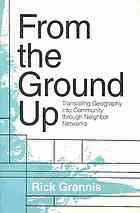
From the ground up : translating geography into community through neighbor networks PDF
Preview From the ground up : translating geography into community through neighbor networks
From the Ground Up From the Ground Up TRANSLATING GEOGRAPHY INTO COMMUNITY THROUGH NEIGHBOR NETWORKS Rick Grannis P R I N C E TO N U N I V E R S I T Y P R E S S P R I N C E TO N A N D OX F O R D Copyright2009byPrincetonUniversityPress PublishedbyPrincetonUniversityPress,41WilliamStreet, Princeton,NewJersey08540 IntheUnitedKingdom:PrincetonUniversityPress,6OxfordStreet, Woodstock,OxfordshireOX201TW AllRightsReserved LibraryofCongressCataloging-in-PublicationData Grannis,Rick,1965– Fromthegroundup:translatinggeographyintocommunitythrough neighbornetworks/RickGrannis. p. cm. Includesbibliographicalreferencesandindex. ISBN978-0-691-14025-4(acid-freepaper) 1.Communitylife.2.Neighborhood.3.Communities.4.Ecology.I.Title. HM761.G732009 307.33620973—dc22 2009003739 BritishLibraryCataloging-in-PublicationDataisavailable ThisbookhasbeencomposedinMinion Printedonacid-freepaper. press.princeton.edu PrintedintheUnitedStatesofAmerica 10 9 8 7 6 5 4 3 2 1 Contents List of Illustrations and Tables ix Prologue xv CHAPTER ONE Neighborhoods and Neighboring 1 Geography and Community 1 It’s the Kids, Stupid! 4 Overview of the Book 8 CHAPTER TWO The Stages of Neighboring 17 Neighboring: A Superposed Relation 17 Stage 1 Neighboring 20 Stage 2 Neighboring 20 Stage 3 Neighboring 23 Stage 4 Neighboring 25 Main Points in Review 27 CHAPTER THREE Reconceptualizing Stage 1 Neighboring 28 Proximity 28 Boundaries 29 Face Blocks 31 Tertiary Face Blocks 32 Intersections 34 Main Points in Review 35 CHAPTER FOUR Reconceptualizing Stage 1 Neighbor Networks 37 Layers of Complex Network Structures 37 T-Communities and Islands 42 Main Points in Review 46 v CONTENTS CHAPTER FIVE Selection and Influence 48 Selecting Homophilous Immediate Neighbors 48 Influence 52 Homophily and Influence Acting on Different Stages of Neighboring 56 Main Points in Review 57 CHAPTER SIX Respondents, Interviews, and Other Data 59 Gang Neighborhood Ethnography and Interviews 60 Overview of the Other Data Collection Events 61 Structured Interviews 61 Cognitive Mapping and Alternatives 62 Data Collection in 68 Los Angeles Neighborhoods 65 Adaptive Link-Tracing 66 The Second Los Angeles Data Collection 67 College Town Census and Resample 68 Administrative Data 70 Main Points in Review 72 CHAPTER SEVEN Selecting Stage 1 Neighbors 73 Selecting Racially Homophilous Tertiary Street Neighbors 73 Accepting Heterogenous Higher-Stage Neighbors 76 A Dialogue with Administrative Data 78 Segregating Tertiary Street Networks 79 Tertiary Street Network Borders 84 The Impact of a Single Tertiary Street Connection 89 Main Points in Review 90 CHAPTER EIGHT Unintentional Encounters 93 The Substantive Reality of Passive Contacts 93 The “Lived” Experience of Tertiary Street Networks 96 A Note about Large, Multiunit Complexes 105 Main Points in Review 107 vi CONTENTS CHAPTER NINE Stage 3 Neighbors and Tertiary Streets 109 Tertiary Street Proximity and Stage 3 Neighbors 109 Tertiary Street Networks and Stage 3 Neighbor Networks 113 More Than Proximity 119 Main Points in Review 127 CHAPTER TEN The Importance of Neighbor Networks 129 Three Degrees of Neighboring 129 A Note about the Exhaustive Census 134 Neighboring Is a Family Relation 135 The Importance of Convenient Availability 139 Main Points in Review 144 CHAPTER ELEVEN Network Influence Theory 148 Social Influence Network Theory 148 Beyond Density 151 The Horizon of Observability 155 Structural Cohesion 158 Merely a Mechanism? 159 Main Points in Review 161 CHAPTER TWELVE Influence Networks in a College Town 162 T-Communities, Children, and the Horizon of Observability 162 T-Communities and Social Control 164 Neighbor Influence and T-Community Culture 166 Main Points in Review 176 CHAPTER THIRTEEN Influence Networks in a Gang Barrio 178 Geographic Neighborhood and Sociological Neighborhood 178 Neighborhood Community and Tertiary Street Networks 180 An Efficacious Neighborhood 182 Neighborhood Efficacy as a Function of Influence Networks 184 vii CONTENTS Influence Networks as a Function of Tertiary Street Networks 187 Main Points in Review 190 CHAPTER FOURTEEN Implications 192 Summary 192 What It All Means 197 APPENDIX Survey Instrument 201 Notes 207 References 219 Index 237 viii Illustrations and Tables ILLUSTRATIONS FIGURE 3.1: Face block 32 FIGURE 4.1: Stage 4 neighbor network 38 FIGURE 4.2: Stage 3 neighbor network, which induces stage 4 neighbor network 39 FIGURE 4.3: Stage 2 neighbor network, which induces stage 3 neighbor network 40 FIGURE 4.4: Stage 1 neighbor network, which induces stage 2 neighbor network 41 FIGURE 4.5: T-communities 44 FIGURE 4.6: Tertiary street island 46 FIGURE 6.1: Distribution of t-community sizes 71 FIGURE 7.1: Pasadena’s tertiary streets by residential demographics 80 FIGURE 7.2: Enlarged subsection of figure 7.1 81 FIGURE 7.3: For spatially adjacent block groups, distribution of absolute difference in population that is white 86 FIGURE 7.4: For spatially adjacent block groups, distribution of absolute difference in population that is Asian 86 FIGURE 7.5: For spatially adjacent block groups, distribution of absolute difference in population that is Hispanic 87 FIGURE 7.6: For spatially adjacent block groups, distribution of absolute difference in population that is black 87 FIGURE 7.7: Demographic differences between spatially adjacent block groups by number of shared tertiary streets 91 FIGURE 8.1: Passive contacts by type 94 FIGURE 8.2: Sample cognitive map 1 99 FIGURE 8.3: Sample cognitive map 2 101 FIGURE 8.4: Cognitive maps compared to tertiary street island map 104 ix
